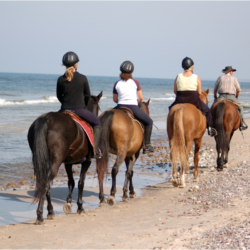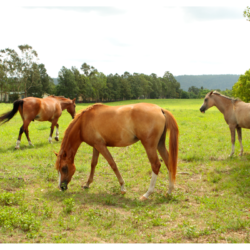Cracks in horses are a common and often painful condition. They mainly appear in winter, caused by dampness and cold, and particularly affect horses living in pasture. This article explores the causes, symptoms, diagnosis, available treatments, natural alternatives and ways of preventing chapping in horses.
What causes this condition?
Crevices are deep irritations located in the hollows of the pasterns and are distinct from mud scabies in that they are more restricted in location. They mainly appear in winter due to the irritating effect of dampness and cold. Irritated skin dries out, cracks and thickens, making it less resistant to surrounding bacteria and increasing the risk of superinfection.
Horses with balzans (areas of white hair at the ends of the limbs) are more susceptible to cracks because of their more delicate skin. Several factors can cause cracks, such as unsuitable ground, poor hoof hygiene or underlying health problems. For example, soil that is too wet or muddy softens the hoof horn, making it more vulnerable to cracking. Conversely, dry, hard ground can cause cracks due to a lack of flexibility.
Inadequate hoof care can also lead to cracks. Poor horn cutting, lack of regular trimming or poor shoeing weaken the hoof structure. Health problems such as fungal infection, metabolic disease or poor circulation can also make hooves more susceptible to cracking.
Cracks often appear in winter, but they can also develop outside this season in horses that are frequently showered or because of unsuitable equipment. Horses living all year round in meadows are more often affected, but those living in stalls are not spared.
What are the symptoms of cracks?
Cracks in horses appear in the form of deep, painful fissures located mainly on the heels or crowns of the hooves. They can cause intense pain, limiting the horse’s mobility and affecting its behaviour.
Symptoms include hair loss, red, inflamed skin and slightly swollen pasterns. Small scabs can also be seen on the affected area. These symptoms are often accompanied by pain and increased sensitivity, making it difficult to handle the affected area.
Horses with thinner skin, such as those with barnacles, show signs of cracks more easily. Their skin becomes red and they lose hair from their pasterns. Horses or ponies with a lot of hair on their pasterns are also more likely to develop cracks, as moisture and dirt accumulate easily in these areas.
If cracks are not detected and treated in time, they eventually form yellowish scabs, become infected and can cause minor bleeding. Slight engorgement may also occur.
What treatments are available?
Treatment of cracks in horses begins with early detection of the symptoms. It is crucial to regularly feel the hollows of the pasterns to detect any roughness or crusting. As soon as signs of cracks are spotted, action must be taken quickly to prevent them worsening.
There are three principles to treating cracks: cleanliness, drying and applying ointment. There’s no point in applying ointment to a dirty, damp pastern – it could even make the situation worse. Start by removing the hair with clippers or round-tipped scissors, then soap the area with an antiseptic soap such as Vétédine Savon. This lathering must be thorough to soften the scabs and allow them to come off without tearing them off.
Next, carefully dry the area to remove all traces of moisture. This step is crucial, as damp skin will prevent the ointment from penetrating properly. Once the skin is dry, apply a healing cream, such as Horse Master crack cream, in sufficient quantity. Gently massage the cream into the skin and apply an extra layer for prolonged protection.
For more serious cases, a vet may prescribe antibiotics or other medication to treat associated infections. It is also advisable to protect the treated area with appropriate dressings to prevent further contamination.
Finally, it is important to follow the treatment protocol rigorously. Apply the ointment twice a day until the cracks have completely healed. For horses living in pasture, try to keep them dry or move them to less damp ground. A layer of petroleum jelly can also be applied to protect the area if they cannot be moved inside.
What are the natural alternatives?
Natural alternatives can be effective in treating cracks in horses, encouraging the natural regeneration of the epidermis. Here are a few options:
- Shea butter: Rich in karitene and vitamin A, shea butter deeply nourishes and moisturises. It supports the skin’s natural regeneration processes, making it more resistant to external aggressions.
- Beeswax: Beeswax forms an impermeable film on the skin, protecting it from external aggression. It is also soothing and rich in vitamin A, which promotes healing.
- Castor oil: Composed mainly of monounsaturated fatty acids, this oil provides optimum protection for the skin and its appendages. It helps to strengthen and repair skin tissue.
- Avocado oil: Rich in fatty acids, carotenoids, vitamins C and E, as well as minerals and trace elements,avocado oil forms a real protective filter against external aggressions.
- Calendula macerate: This macerate has soothing properties thanks to its high content of unsaponifiable fatty acids. It soothes irritation and promotes healing.
- Comfrey extract: Rich in allantoin,comfrey extract supports the skin’s natural regeneration processes.
A mixture of shea butter, beeswax and castor oil can be used as a repairing ointment. Peru balsam, a thick brown resin from a tree native to Central America, is also renowned for its purifying and repairing properties.
Zinc oxide, commonly used in cosmetology, has soothing and purifying properties. It also acts as a UV filter, protecting the skin from the sun’s rays. These natural treatments can be found at your vet’s or chemist’s in a range of formulations tailored to your horse’s specific needs.
What are the preventive measures?
Preventing cracks in horses is based on rigorous hygiene and regular hoof maintenance. Regular trimming, proper horn trimming and proper shoeing are essential to maintain healthy hooves. It is also crucial to keep hooves clean and dry, avoiding muddy or excessively damp ground wherever possible.
Brushing and drying the horse’s limbs after each ride is an important preventive measure. Use a soft brush to remove any sand stuck to the limbs, then dab with a clean terry cloth to remove any moisture. Avoid frequent showering of the limbs, especially in winter, as this encourages the development of cracks.
When clipping, avoid clipping the limbs flush and leave the dewlaps in place so that they can act as natural gutters, draining water and preventing it from accumulating on the pasterns.
The fit and cleanliness of bells and gaiters are also important. Ill-fitting or dirty equipment can cause irritation and encourage the development of cracks.
For horses that live in pasture all year round, it is possible to clean up trampled areas that turn into quagmires in wet weather. Use special rubber slabs or sand, or move the fodder rack regularly to prevent the build-up of moisture.
Finally, keep a regular eye on your horse’s general health. A balanced diet, regular exercise and regular visits to the vet for a full health check can help prevent cracks.





